The
5
Outdoor Features
That Add Value To Your Home
Let’s face it:
When it comes to real estate, first impressions matter – and more than they ever have before.
Today, your home’s exterior comes into play way before potential buyers arrive at your door. With dozens of real estate apps and sites eager to present buyers with unlimited options, attractive photos of your home are essential in intriguing property seekers.
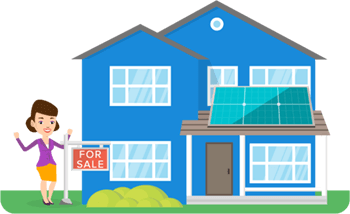
In this world of digital curb appeal, a shabby exterior can be a serious problem for sellers.
In a 2016 survey, a whopping 99 percent of realtors considered it an important consideration in attracting a buyer.
We’ll call it the Tinder Effect:
Present an ugly facade, and fewer searchers will give your home’s inner beauty a chance. If you’re looking to attract the greatest possible number of buyers, exterior upgrades are a must.

Here’s an even better reason to invest in the outside of your home:
Modest improvements can create more value than you may expect. This means less risk and reliance on contractors – music to the ears of those who are cautious about their capital.
Better yet, you won’t be displaced during outdoor additions, the way an interior remodel might disrupt a key living area you and your family use every day. Anyone who’s gone without a kitchen for a couple of months can attest to the misery of having a gaping hole in your domestic space. By contrast, many exterior improvements can take just a weekend and won’t throw your family life for a loop. Aside from some noise and the temporary eyesore of construction outside, your inner sanctum will go untouched.
We know what you’re thinking: We’re still talking about home remodeling, right?

Isn’t upgrading your home supposed to involve high levels of stress and expense? Doesn’t every project worth doing have hidden risks and the threat of financial ruin?
If you’re waiting for the other (steel-toed) shoe to drop, don’t. When you stick to the exterior, upgrades to your home can be both speedy and easy – and often pay off regarding the return on your investment. The pay-off may not be quite as dramatic as, for instance, a solid investment portfolio catered by the most advanced algorithms, but it's one you'll reap the rewards for as long as you stay in your home.
Where’s the proof? Well, that’s why this comprehensive guide exists. We’ll take you through the top five exterior features that add value to your home, outlining your best investment bets concerning exterior upgrades. By the time you’re done, you’ll feel like an outdoor features evangelist.

5 Outdoor Features
To Add Value To Your Home

Some Love for Your Lawn
Lawns are a big deal in America, and we mean that quite literally. Like, nearly 50,000 square miles of lawn big, or an area greater than Mississippi. This means there’s a good chance your home has one, and you’ve got plenty of competition for the best grass around.
You may not be a passionate lawn enthusiast, but there’s no question it’s an object of emphasis among homeowners. The average American spends roughly 70 hours a year working on lawn and garden care, using 9 billion gallons of water per day. The National Gardening Association adds that the average American household spends $347 a year on lawn and garden care as of 2013.
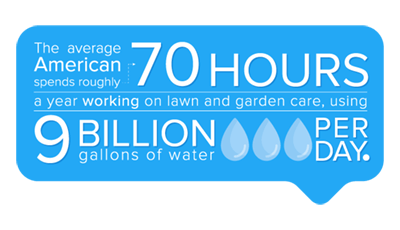
Why are we so good to our grass? Because we see it each time we enter our home? Or are we just afraid of attracting neighborly judgment? All vanity aside, a good lawn means green in more ways than one. According to Coldwell Banker, immaculate landscaping can add up to 15 percent to a home’s value.
But what if you’ve been slacking? We can’t blame you: Lawn care isn’t exactly most people’s idea of a good time. In fact, 20 percent of Americans called mowing their lawn their least favorite household chore. If you loath the work a lawn requires, you may let your landscaping go a bit. However, this might come back to haunt you if would-be buyers notice.
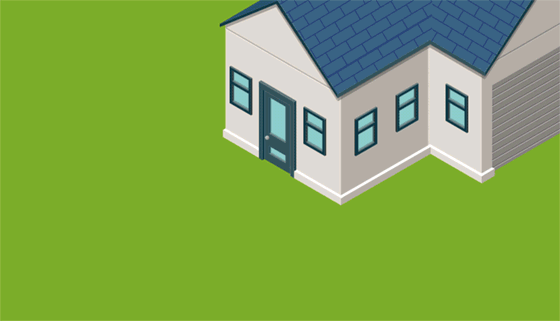
Never fear: At a relatively small cost, landscaping professionals can restore your lawn to pristine condition. That’s a move many real estate agents advocate when a homeowner approaches a sale. Here’s a list of some inexpensive lawn fixes that will add true value to your home, according to a report issued by the National Association of Landscape Professionals and National Association of Realtors.
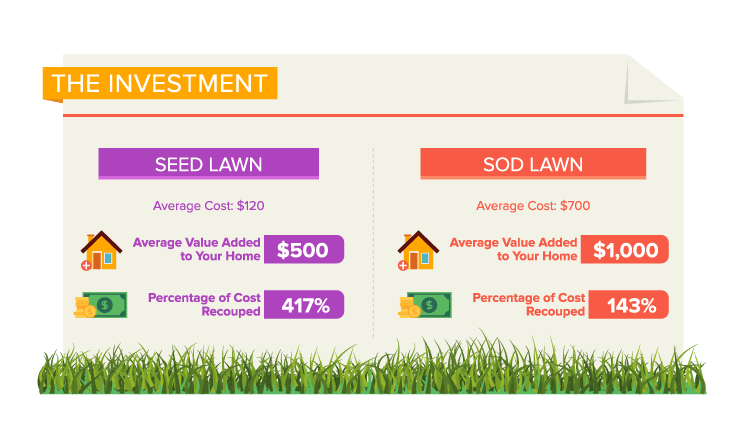

Flower-Powered Landscaping
We get it – when we talk about building the value of our homes, gardening doesn’t exactly top our priority list. But maybe it should. Rejuvenating your home’s landscaping is actually a top recommendation from the National Association of Realtors, with 47 percent saying they’ve suggested landscaping changes to sellers.
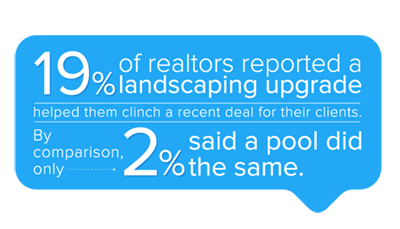
The proof is in the pudding: 19 percent of realtors reported a landscaping upgrade helped them clinch a recent deal for their clients. By comparison, only 2 percent said a pool did the same.
Even better: Landscaping doesn’t come anywhere near a pool installation regarding pricing. With so many options for materials and design, you’re sure to find upgrades your budget will accommodate.
Realtors and landscape pros will break down your options into two categories: landscape and softscape projects. While the terms are sometimes used interchangeably, a softscape project refers to plant life. Think trees, shrubs, and flowers. Landscaping involves nonliving interventions, such as a stone pathway or a mulch area. Here’s a typical project of each kind.
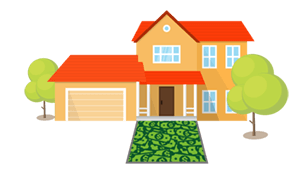
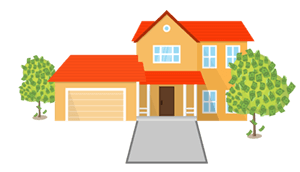
- Landscaping: Install a front walkway of natural flagstone 3 feet wide and 30 feet long. Add two stone planters 6 feet long and 2 feet wide.
- Softscaping: Install five trees, 25 shrubs, and 60 perennials.
In combination, these methods can create powerful appeal to potential buyers. Homeowners may be looking at a patch of dirt to call their own, but bare outdoor space is unlikely to impress them. Here’s how much value these upgrades could add to your home.
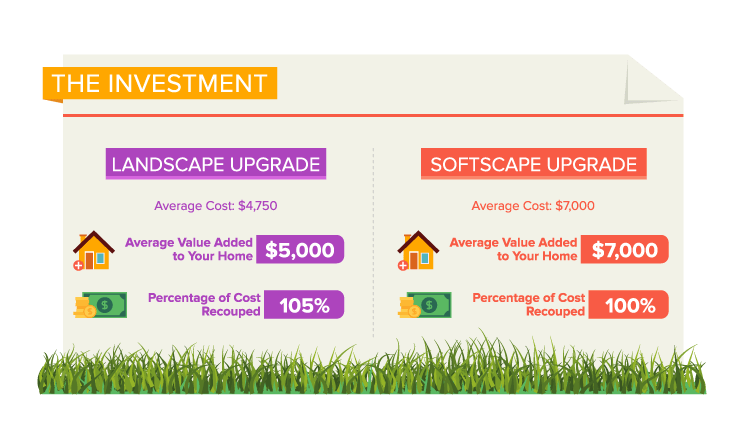

The Perfect Patio or Deck
While well-kept lawns and lovely landscaping never go out of style, the patio is really having a moment in our country. According to CityLab, America is seeing “an explosion in sales of homes with patios,” and 56 percent of single-family homes in 2014 had one. If the patio used to be considered an exceptional asset, it has increasingly become a basic expectation.
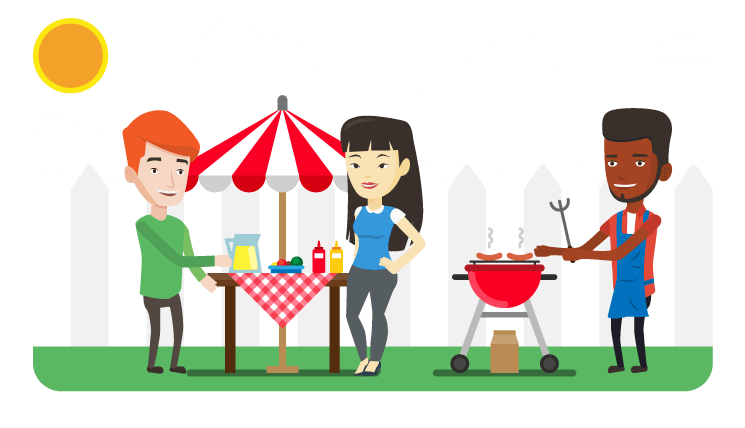
That’s especially true in areas where outdoor space is particularly valuable when the weather heats up. In the West South Central region of the U.S., for instance, 79 percent of new single-family homes have a patio.
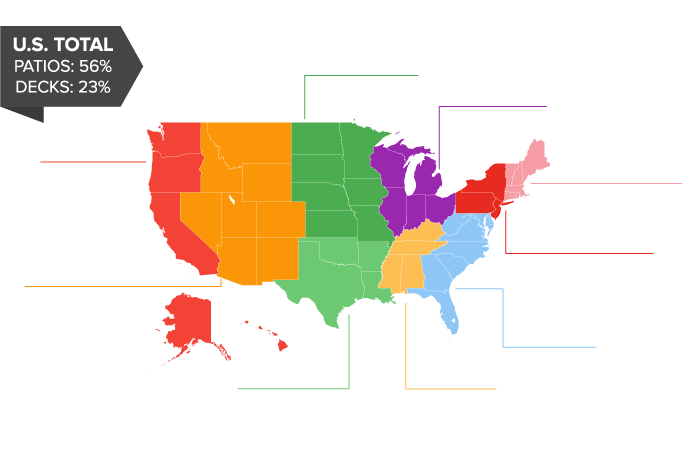
Not interested in joining this patio party? Set your sights a little bit higher – in the literal sense. While less common than patios in new homes nationwide, decks are somewhat more common in new homes built in the Northeast.
Expect to spend slightly more to elevate your outdoor space, but you’ll most likely make it back in the long run. What’s more, decking is now available in a myriad of materials, from pressure-treated lumber to composites that combine wood fibers and recycled plastic. This means you have options when it comes to choosing a deck that will resist decay in your local climate and still fit your budget.
Here’s the real value you’ll see for patios and porches.


A First-Rate Fire Pit
For those who feel fires are best reserved for camping, the value of an outdoor fire feature adds up to so much more than s’mores. Once seen as a luxe touch favored by the likes of Celine Dion, fire pits currently enjoy a much broader – and egalitarian – appeal. In fact, the American Society of Landscape Architects rated fire pits and fireplaces the most popular outdoor design trend of 2016.

Chalk it up to the patio boom mentioned above: These fire elements are a great option to serve as the focal point for outdoor gatherings. Recognizing this demand, big-box home improvement retailers now offer affordable fire element variations for as little as $100. While you can’t count on these low-scale options to pay off in any permanent way, they are a testament to burgeoning interest across the country.
A slightly scarier indication of the fire pit trend: They’re causing more injuries. The National Fire Protection Association says fire pit industries nearly tripled in the six-year period measured (from 2006 to 2012). Financial incentives aside, when you’re weighing the value of a fire pit, your primary investment should be safety. After all, there’s no benefit in an investment that burns down your home. Realtors recommend dry stacked stone and a gas burner as the most sensible options for fire pit construction and their placement on a patio that’s at least 10 feet in diameter.
Thankfully, at least your money won’t be in peril when you invest in a fire pit. Here’s what you stand to gain from this exterior upgrade.
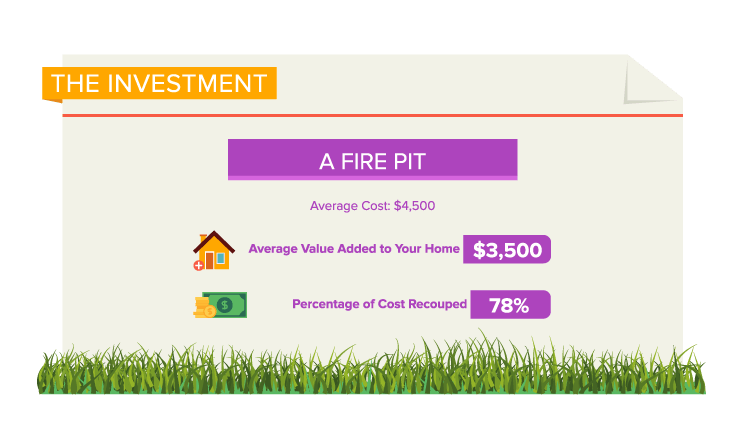

Superb Solar Panels
Thus far, the outdoor features we’ve mentioned all possess subjective value. Experts say they’re aesthetically or functionally advantageous in the eyes of buyers. But while landscaping upgrades or a fire pit serve as excellent attractions, they may be subject to changing tastes or other market factors moving forward.

What if there were an exterior improvement guaranteed to provide value to future buyers, regardless of differences in trends and taste? And what if it could save you real money in the meantime?
This brings us to our final – and most adamant – exterior recommendation: adding solar panels to power your home. We’re preaching the solar gospel to all rational remodelers because this addition is a complete no-brainer.
For years, the one knock on solar was its upfront cost. For consumers otherwise eager to reap monthly utility bill savings,
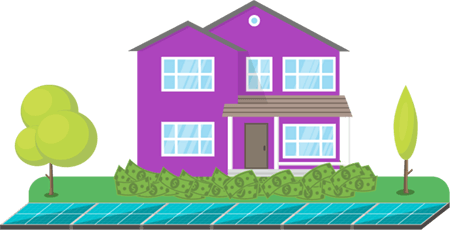
the installation investment of several thousands of dollars was a major obstacle. In what time frame would they see a return on investment? Could they create value more quickly through other investments?
Here’s the good news for those looking to marry environmental and economic concerns: If you install solar panels, the project will more than pay for itself whenever you sell your home.
According to research from the U.S. Department of Energy and Berkeley Lab, homebuyers are willing to pay $15,000 more on average for a home with an
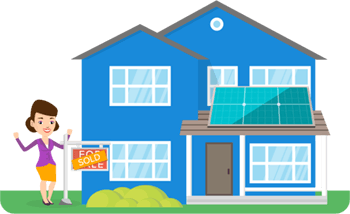
average-size 3.6 kilowatts solar system. Using a current installation cost estimate of $3.36 per watt, this means you’d be paying $12,096 to add $15,000 of value to your home.
But it gets better. Thanks to a federal solar tax credit program, you can deduct up to 30 percent of the cost of your solar panel installation from your income taxes. That brings our average installation cost down to $8,467.
This makes solar panels, by far, the best outdoor feature investment regarding added value.
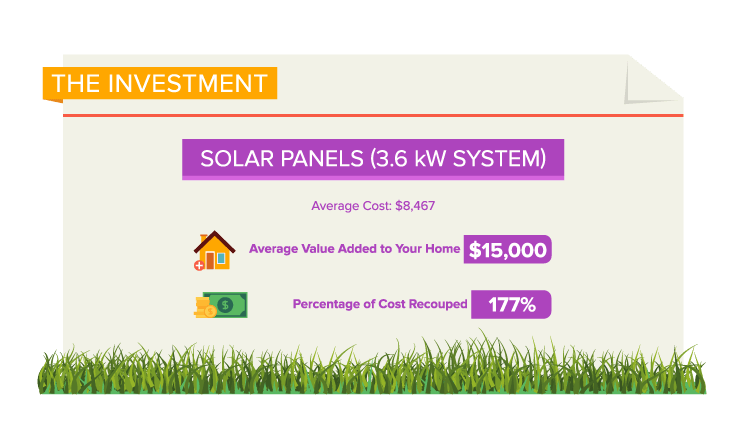
Remember, you’ll make this profit on top of significant savings every month on your electricity bills. Over a 20-year period, these monthly savings could total $30,000, depending on where you live.
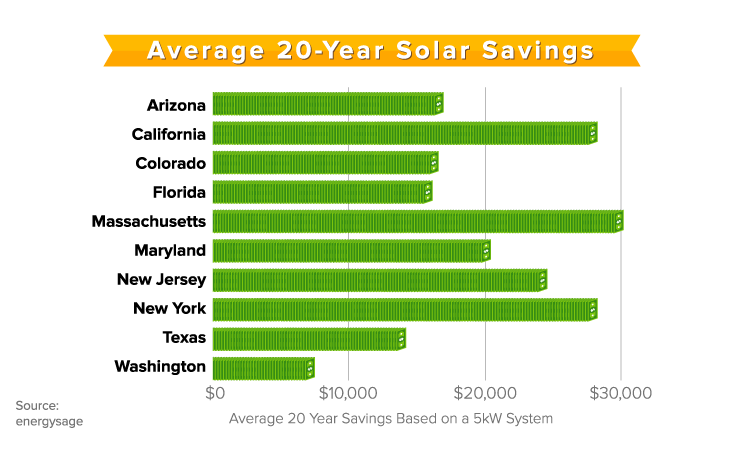
What’s not to love about this math? If you’re looking for an investment that adds immediate value and creates savings every day, there is simply no better option than solar.
To find out just how much solar could save you, use our free tool to calculate your potential savings!
